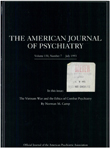Somatization and psychiatric disorder in the NIMH Epidemiologic Catchment Area study
Abstract
OBJECTIVE: Somatization has often been viewed as a defense against awareness of emotional distress or as a masked version of depression. This report examines whether community residents with high levels of functional somatic symptoms also report overt psychological distress and whether somatization is associated with any specific psychiatric disorder. METHOD: Analyses used data from the community sample of the National Institute of Mental Health Epidemiologic Catchment Area (ECA) study, a population-based survey of psychiatric morbidity among more than 18,000 residents of five U.S. communities. RESULTS: Increasing number of somatization symptoms was strongly associated with overt expression of psychological distress and psychiatric symptoms. Among ECA respondents with five or more current functional somatic symptoms, 63% reported current psychological symptoms and 50% met criteria for a current psychiatric diagnosis (compared to 7% and 6%, respectively, among those with no current somatization symptoms). Somatization symptoms showed strongest associations with anxiety and depressive symptoms, intermediate association with symptoms of psychotic disorders, and weakest associations with symptoms of substance abuse and antisocial personality. CONCLUSIONS: ECA study respondents with high levels of somatization symptoms typically reported overt psychological distress, especially anxiety and depression. Patterns of response do not support a dissociation between physical and emotional symptoms. Functional somatic symptoms appear to be common expressions of distress instead of defenses against awareness.
Access content
To read the fulltext, please use one of the options below to sign in or purchase access.- Personal login
- Institutional Login
- Sign in via OpenAthens
- Register for access
-
Please login/register if you wish to pair your device and check access availability.
Not a subscriber?
PsychiatryOnline subscription options offer access to the DSM-5 library, books, journals, CME, and patient resources. This all-in-one virtual library provides psychiatrists and mental health professionals with key resources for diagnosis, treatment, research, and professional development.
Need more help? PsychiatryOnline Customer Service may be reached by emailing [email protected] or by calling 800-368-5777 (in the U.S.) or 703-907-7322 (outside the U.S.).



